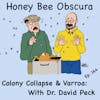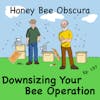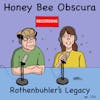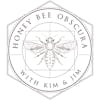Barrel Hives with Jerry Hayes (147)

This week, Jerry Hayes sits in with Jim while Kim is out. In this episode, Jerry talks about one of the most unusual hive designs he's ever built and worked with... a hive made out of a old 55-gallon drum. We know honey bees will build their nests...
This week, Jerry Hayes sits in with Jim while Kim is out. In this episode, Jerry talks about one of the most unusual hive designs he's ever built and worked with... a hive made out of a old 55-gallon drum.
We know honey bees will build their nests just about anywhere... but is this practical? Useable? Find out by listening today!
What is your most unusual hive?
______________________
Thanks to Betterbee for sponsoring today's episode. Betterbee’s mission is to support every beekeeper with excellent customer  service, continued education and quality equipment. From their colorful and informative catalog to their support of beekeeper educational activities, including this podcast series, Betterbee truly is Beekeepers Serving Beekeepers. See for yourself at www.betterbee.com
service, continued education and quality equipment. From their colorful and informative catalog to their support of beekeeper educational activities, including this podcast series, Betterbee truly is Beekeepers Serving Beekeepers. See for yourself at www.betterbee.com
______________________
Honey Bee Obscura is brought to you by Growing Planet Media, LLC, the home of Beekeeping Today Podcast.
Music: Heart & Soul by Gyom, All We Know by Midway Music, original guitar music by Jeffrey Ott
Cartoons by: John Martin (Beezwax Comics)
Copyright © 2023 by Growing Planet Media, LLC

Episode 147 – Barrel Hives with Jerry Hayes
[music]
Jim Tew: Hi, listeners, I'm Jim Tew at Honey Bee Obscura, where every Thursday, we talk about something that concerns bees. Kim is still on medical leave, folks. I'm sorry to have to tell you that, but he's getting better. I got Jerry Hayes filling in. Jerry is the current editor of Bee Culture Magazine. Jerry, how's it going?
Jerry Hayes: I've only been doing this for about five years. I've never been an editor before, and I learned a ton, basically, from the two people in our department, Emma and Jen. They're younger and smarter digitally than I am, and so we all work together, and it's been a fun entrepreneurial adventure.
Jim: Well, I'm glad to hear you so positive about this. Shouldn't you be down in the dumps?
Jerry: Not when I'm being recorded. No, sir.
Jim: Oh, okay. Okay. Well, I didn't realize that made a difference.
Jerry: Yes.
Jim: Well, I'm glad you're here, buddy. Well, listeners, Jerry and I go back a long way. I've admitted to you in previous episodes, as has Kim, about how we've grown old. Are you ready to admit that, Jerry?
Jerry: I think I am, and as you get older, and whoever's listening will know this, and whoever's younger will experience it, when you have years, decades behind you, and you've built up all these thoughts and memories and failures and successes, and look behind you, look over your shoulder, and see what brought you here, I just think that's amazing.
Jim: Well, I'm glad to hear it worked out that well. Let's do it like this. Let's be formal about this. Let's do it correctly. Hi, I'm Jim Tew.
Jerry: I'm Jerry Hayes.
Jim: We want to talk to you today from Honey Bee Obscura about a topic in beekeeping that I don't think Kim and I have ever discussed, and that's unusual hive designs that Jerry had a lot to do with when he didn't have so much gray in his hair.
Jerry: I had no gray in my hair.
[music]
Introduction: You are listening to Honey Bee Obscura, brought to you by Growing Planet Media, the folks behind Beekeeping Today Podcast. Each week on Honey Bee Obscura, hosts Kim Flottum and Jim Tew, explore the complexities, the beauty, the fun, and the challenges of managing honey bees in today's world. Get ready for an engaging discussion to delight and inform all beekeepers. If you're a long timer or just starting out, sit back and enjoy the next several minutes as Kim and Jim explore all things honey bees.
Jim: Jerry, specifically, what I had in mind was an episode with this Hayes hive, I named it, all those years ago. Can I say that I thought I remember it came about because I was tinkering with top bar hives and Botswana long hives, and you came up with an idea that I thought was about the dumbest thing I'd ever heard, but it worked. Are bees tolerant of us in oh, so many ways?
Jerry: Bees are amazingly tolerant of us, and I think you and I have talked in the past of who's managing who. Beekeepers do all these things and crazy things, and if we meet some type of modest qualifications of the bees, they'll put up with us. Yes, this is an amazing adventure in beekeeping, and honeybees are super thoughtful for us.
Jim: Tell us what you came up with to test all that you just said.
Jerry: Well, let me back up a little bit and tell the listeners that I started out in life as a high school teacher, didn't like it, and I went into another business, and the guy I was working with was a beekeeper from Wisconsin, actually. I lived way out west at that time. Everybody knows about honey bees, but nobody actually knew a beekeeper back then. Oh, my gosh, and so I picked this person's brain and asked more questions and became more interested and fascinated and asked more questions, and then I started reading everything that you could read about and looking into honey bees, and then I turned into the consummate backyard beekeeper.
I did all the goofy things that we backyard beekeepers do. I made things, I built things, I tried things, what have you. Then after a while, I thought, could somebody actually make a living doing this and help take care of a family? I applied to OSU under your program, and I applied to up in Canada at the time, Peace River had a college and focused on agriculture. Actually, OSU got me in sooner than Peace River, so we loaded up the U-Haul and drove to Ohio and Worcester.
Don't let this go to your head now, but other than being a husband and a father, you're number three on my list of the amazing things that I've been able to experience in my life because your demeanor, your educational outreach, everything in the classroom, driving us down in cars and buses to Dothan, Alabama, to look at bees and, oh, my gosh, and I'm going to diverge here. We looked at bees to Dothan, I think we take them to Dothan or take them back up to Ohio, and we had a truckload full of bees, and I had my bee suit on.
We stopped and you told me that we needed to unload the bees or uncover them or something to have my bee suit on. When we stopped the truck, there was probably 80,000 million bees flying in the air. I looked around and all the other students and you were running away from the truck. I thought, "Oh, okay, all right. I'm in charge now. This is good."
Jim: I don't remember any of that now. Are you making this up? This was supposed to be a factual discussion.
Jerry: No. This is in my head. What were the students we had from Asia? Where were they from?
Jim: Burma?
Jim: Burma. I remember when in Dothan, we were in the field and there was three of them, and they wandered off from the apiary out into the woods, and that was the last time we saw them for the rest of the day.
Jim: They sound like intelligent people to me in retrospect.
Jerry: Anyway, those are the fun memories. One, I want to thank you for sparking my journey in this industry. That has been amazing for me to be able to have that interaction, that value of an insect and an insect that will hurt you.
All right. The hive, the Haynes Barrel Hive. Yes, you are working on top bar hives, and this is how my brain works. I apologize. You were doing Kenya top bar hives, whatever you want to call them now. I was thinking in my brain, well, bees in the wild at that time, this was before Varroa, when you actually could find bees in the wild, build their comb in the shape of an ellipse, naturally. I thought, "Well, you know what, an ellipse is half of a circle, and if it's a half of a circle, what is out there that's free, that represents half of a circle?"
I thought, "Well, a 55 gallon barrel, if you cut it in half, is an ellipse, and I could turn that into a top bar hive." I had one of the people there at ATI in Worcester, who was smarter and had the power equipment that I didn't have, cut this 55 gallon barrel in half for me. I made a plywood end at the other ellipse, and then I put some runners on the side to hold the top bars in, and the entrance was the actual hole that you would pour out the liquid that was in the hive and put some bees in there, and they seemed to be okay with it.
It's like bees everywhere else. If you give them the right amount of volume, they will live in it because I've seen bees build in Florida when I was in Florida, Africanized bees in mailboxes in the trunk of old Buicks and all that other stuff.
Jim: Every barrel that you saw after that, you saw two potential beehives.
Jerry: I sure did, and golly, this was several, many years later, I was looking at a magazine about top bar hive beekeeping in Africa, and they were showing different hives, and I'm sure they didn't get this from me, because this isn't rocket science, anybody can figure this one out, but they showed somebody who had got a barrel and done exactly the same thing I did to it and turned it into a hive. I contacted somebody and they said, "Yes, it works pretty good, but unless the barrel has a big, huge hole in it or is smashed on one side or whatever, the barrel is more valuable as a barrel than as a potential beehive." They were doing the same thing and I just thought that was fun.
Jim: Well, I was thinking when you were talking how much time has changed because barrels are plastic now. You don't get those metal barrels anymore. Beekeepers out there who want to copy you are going to have to modify your design to use a plastic barrel and cut in half.
Jerry: Yes,
and they could do it. The interesting thing was that, we're talking about metal, we're talking about steel barrel, and we're talking about Ohio, and could the bees overwinter in something that has no insulation in it? They did and were able to do it, and actually I took the other half of that barrel hive when I went from Wooster, Dadant offered me a job as a branch manager in Wayland, Michigan.
I took the other half up there and started a barrel hive in Michigan and they overwintered as well. Bees are amazing. We look at all these advertisements for insulation and all these other kinds of things for bees, but if bees are healthy, they can do all sorts of amazing things.
Jim: They are tolerant. Jerry, let's take a short break, hear from our sponsor, and when we come back, tell us what you use for top bars.
[music]
Betterbee: Are you ready to savor the sweet rewards of beekeeping? Look no further. Better Bee is proud to offer honey extraction and processing equipment, brought to you by the renowned Lyson. Lyson is a global leader known for their impeccable craftsmanship and cutting edge designs. Unlike other options, Lyson extractors boast unrivaled durability and are certified food grade, making them safe for health and the environment. Plus, the rust resistant stainless steel is a breeze to clean, promising an extended service life. From four frame to 56 frame extractors, we've got you covered. Visit betterbee.com/extract to explore our wide range of options.
Jim: I got the barrel concept figured out. What did you use for top bars?
Jerry: I went to, I forget, Lumber Company, and I got, I think, ooh, inch and a half, maybe strips of wood that time. What I did was there again, I was with you and we were living in a trailer and I didn't have all sorts of stuff. What I did was take foundation, a strip of foundation and a torch and I melted the end of that foundation to that wood that was the proper length that would fit across that barrel and those strips. I told you I put in there to hold the thing so we could put a lid on it. Then the bees took that and built top from it and attached it more securely to the top bar and poof, there you go.
Jim: You just used wooden slats?
Jerry: Yes, I sure did.
Jim: What about it? An inch and a quarter wide, inch and a half wide or something like that?
Jerry: Yes, something like that, and then what I did, I told you, I put those wooden strips along the side below the edge of where we cut the barrel so that I could put a lid that I built on top of that. I think I put in eight frame comb spacers, those metal comb spacers on there so that I could space those frames out and hold them in a certain position. They seemed to do that and drew the comb out nicely.
Jim: Well, the thing is, and you've said it several times, maybe I've said it too, but the bees are just looking for a cavity. What we're trying to do is to make them work in that cavity on a comb that we can take out when you want to and have a look instead of just having everything cross-combed up.
Jerry: Yes, no, and it's true. Yes, to be able to manage the bees so that they can be successful and we can be successful and all these people out there that have these new hives that allow the comb to go all sorts of places and connect to each other and that you can't manage it. You can't open it up. With our problems with pest parasites and diseases now, which is worse than when we started, you have to be able to manage it.
If you can't manage bees, if you can't be a good beekeeper manager, you need to go into stamp collecting or something else because this is an animal. This is like your dog or your cat. You're not going to take care of your dog or your cat, if it's covered with fleas and ticks or it's not eating properly or what have you, no, we're responsible for this very valuable insect.
Jim: I can't say it any better. It is a responsibility that I frequently fail, but I know that I should be working harder. I agree with you completely.
Jerry: No, and that's it. You're exactly right. None of us are perfect beekeepers, and yes, we have all these plans in spring that I'm going to look at bees every two weeks or I'm going to do-- No, it doesn't happen, but there's got to be that list of four or five things that we absolutely positively have to do in order to keep the bees healthy, not only for that season, but the bees are always preparing for winter. They're temperate insects. They're always preparing for winter. We need to help them prepare for winter and then give us a little surplus.
Jim: This wasn't all you tinkered with. The little bit of time we have left, you've had an interesting project where you looked at where the bees would want their entrance on standard equipment. I've cited you off and on, even though it was just a very informal review. Tell us what you did there in the last few minutes.
Jerry: There again, like we all do as beekeepers, I read a lot and I was reading sometime about wild hives at that time that lived in hollow trees. If I remember correctly, they said that the wild nest, if they could, would select an entrance above the brood chamber. That doesn't mean that they wouldn't have comb above for that.
The reason for that, I remember the article saying was that, you could maintain or the bees could maintain temperature and humidity in that with the entrance above the brood area, rather than one below that might have breezes or what have you blowing in it. Then the bees like an entrance above that. I experimented with our Langstroth colonies with entrances above the brood nest. I still do it. I still do it at home in different ways too.
Jim: If you gave the bees an option at every level, the bottom board and between every deep and super, where did the bees choose?
Jerry: I have a hive-- I'm still messing around with this. I have a hive-- two hives in my yard right now that have a full bottom entrance. I put a couple of sticks in above the brood nest to create another entrance, and then I put a big thick foam insulation stuff that I was using to do something at home with and made an entrance and put that on the very top of the hive with the lid on it, of course, just to see, as you just said, with the bees, our bees now still select something above.
Yes, some of the bees will still want to go in the bottom, some will be in that middle entrance, but the majority of bees would go to that top entrance. I left that foam thing with the top entrance on all summer. This isn't winter and it's just to see what they would do. The bees actually in two or three different places chewed through, that's the wrong term, but they made holes through this insulation at the very top in a couple of different places so more bees could use the very top entrance. I just find that fascinating.
Jim: Well, I do too. The thing you said all those years ago was that in reality, the bees didn't use the bottom entrance very much.
Jerry: They don't. That's in the wrong-- Everything about a beehive, a Langstroth hive, except volume, might be wrong. We have these bottom doors with that little porch on the front and a door and a doorbell and everything of it.
Jim: Close to good schools and shopping centers.
Jerry: The hive is built for us. Being all visual creatures, we can understand when you have an entrance at the bottom and you have a little porch where they could fly in and land and be comfy and invite their friends in and everything else, but that's not what the bees actually do. Yes, they can do that, but they have something genetically in their brains that if we have an opportunity, we would like an entrance in a different spot.
Jim: Well, it was very intriguing. Jerry, time has flown by. I don't want to scare you, but maybe we can do this again on erratic occasions, on erratic subjects. I enjoyed talking with you. I've had so much experience with you and we've had so many events all through the years. It's easy to burn up 20 minutes in a hurry.
Jerry: No, it's super fun, and as a beekeeper, it's fun talking to and about bees. Thank you for the opportunity.
Jim: Well, I enjoyed listening. It was good to walk down memory lane for a bit. For anybody who wants to build a Hayes Barrel Hive, it's a piece of cake. All you got to have is a cutting torch and about $30,000 worth of shop equipment and you're good to go or something along that line.
Jerry: No, you only need about $25,000.
Jim: Okay. The biggest thing you're going to have trouble finding is the metal barrel now, I'm afraid. Jerry, until we can talk again, I had a good time. Thank you, friend.
Jerry: Thank you, Jim.
[00:20:05] [END OF AUDIO]
New to Honey Bee Obscura Podcast?
Here are some great episodes to start with. Or, check out episodes by topic.







 This week, Jerry Hayes sits in with Jim while Kim is out. In this episode, Jerry talks about one of the most unusual hive designs he's ever built and worked with... a hive made out of a old 55-gallon drum.
This week, Jerry Hayes sits in with Jim while Kim is out. In this episode, Jerry talks about one of the most unusual hive designs he's ever built and worked with... a hive made out of a old 55-gallon drum.





